Beautiful Plants For Your Interior
Gardening Month by Month – June
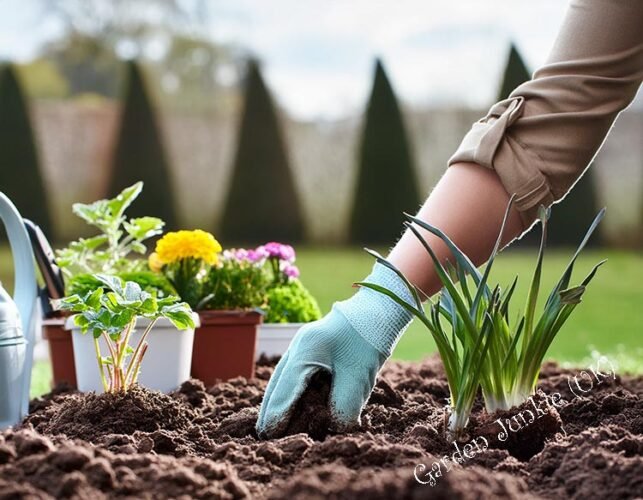
Choose Your Gardening Month by Month –
Gardening Month by Month – In June, as set out every month for our readers, we continue our regular monthly gardening section, which hopefully provides practical, informative checklists and reminders to help guide you through various gardening tasks for each month.
Our page Gardening Month by Month – June like other similar monthly pages offers helpful reminders and tips for tending to your garden, allotment, greenhouse, pond, and general garden maintenance.
Many of these gardening activities are tailored to specific months or even gardens, therefore not all may be useful. However, on this page, we looked at what tasks may require your focus in and around the garden, allotment, pond and greenhouse during June.
Gardening Month by Month – June
June arrives with longer days, balmier evenings, and the promise of a bountiful harvest. For UK gardeners, it’s a time to reap the rewards of your spring efforts in the garden and ensure continued growth throughout the summer.
From nurturing flourishing greenhouse plants to maximising harvests on your allotment and maintaining a healthy pond, June offers a wealth of exciting tasks to keep your outdoor space thriving.
So, prepare to soak up the sunshine and get ready to witness the magic of your garden come alive! It should even be time to bring out and dust off your BBQ from last summer and enjoy your outside space with family and friends.
In June: Garden, Allotment, Flowers, Greenhouse.
With the 21st of June, the longest day of the year, June provides all that additional light and hopefully, heat which stimulates the garden to experience a lively and rapid period of growth.
June is the heart of the British summer, seeing our gardens bursting with vibrant blooms and delicious harvests! Here’s a quick guide to keep your garden, allotment, flowers, and greenhouse thriving this month:
If you want to plant strawberries (Fragaria × ananassa) this year and if you haven’t already planted, now is the last chance to get those summer-bearing Strawberry bare-root runners in the ground. Plant them now in time to give you a bumper summer harvest. Some of the popular varieties include (early summer fruiting) Honeoye, (mid-season Cambridge Favourite, Marshmello and Hapil or (late season) Symphony,
Plants that come back year after year (Perennials) in our garden borders often grow vigorously, after bouts of rain and sunshine. This growth can make them prone to falling over in bad weather. This is especially true for tall plants and hybrids with big flowers, as they are more likely to need extra support. Delphiniums (Delphinium elatum), Sunflowers (Helianthus annus) and Hollyhocks (Alcea rosa) are prime examples. To prevent this, it’s important to provide support for them early in the growing season.
If you’ve been carefully tending to your vegetables in the allotment, you can look forward to a bountiful harvest in June. Some of the vegetables typically ready to be harvested in June include Turnips, Potatoes, Cauliflower, Lettuce, Spring Onions, and Carrots to name a few.
To create a thriving environment for your greenhouse plants on hot days, consider a two-pronged approach: humidity and feed. Regularly dampen the floor to boost moisture levels. This not only benefits plant growth but also discourages pests like the red spider mite. To further encourage your plants to flower and fruit, water with a liquid feed.
Checkout Our June Gardening Checklist:
- Continue to prepare summer ‘hanging baskets‘ and containers by filling them with a selection of vibrant bedding plants to create a colourful and lively display throughout the season, Argyranthemum, Lysimachia nummularia (Creeping Jenny), Trailing Lobelia (Lobelia erinus) and Nicotiana (Tobacco plants) are popular choices. Alternatively, consider using herbs, shrubs, and evergreen plants to create a long-lasting and visually appealing arrangement.
- Trugs can be planted up with summer bedding as well if not done already. Keep them well-watered, and consider utilising rainwater that has been collected or recycled grey water whenever it is feasible to do so.
- Once tulips have finished blooming, dig up the bulbs and store them ready for next year’s colourful display.
- If you want to try taking ‘cuttings‘, try Pinks (Dianthus) and Carnations (Dianthus caryophyllus) for more blooms! Clip healthy, non-flowering shoots – they’ll root easily.
- Continue to ‘prick out’ and transplant your growing seedlings and cuttings.
- Continue to keep an eye on greenhouse temperatures. Open vents and even the door if temperatures rise too much on warm days. Provide shading as necessary.
- Keep your greenhouse tomatoes happy with regular watering to avoid ‘split fruits’ and blossom end rot.
- If you have experienced issues with ‘vine weevil’ in the past, it is advisable to use vine weevil control on your pots, particularly this month, as the larvae of this pest become active during this time.
- Prune spring-flowering shrubs, clip ‘buxus’ topiary plants and make sure to cut evergreen hedges all the way down to the bottom to maintain their dense growth.
- Continue to inspect your greenhouse plants every few days to assess their watering needs, as they may require attention. Seedlings, in particular, may need daily monitoring.
- Sow ‘biennial flowers’ such as Foxgloves, Honesty, Wallflowers, and Sweet Rocket in seed trays.
- If you have ‘Sweet Peas‘ note that when they begin to bloom, continue to pick them regularly to stimulate further flowering. Ensure that the plants are adequately watered during hot weather, and apply liquid seaweed fertiliser every two weeks to promote additional growth.
- It is essential to stay vigilant in controlling weeds. Use a ‘hoe‘ to remove weeds between rows, and allow the seedlings of ‘annual weeds’ to dry out on the soil surface. Remove when dry.
- To encourage additional growth during the summer, it is recommended to ‘pinch out’ the tips of fuchsias.
- Turn and rotate the ‘compost‘ in your bin to ensure it remains properly aerated.
- To save some costs and water, avoid the urge to water well-established lawns, even during dry periods. Grass can handle drought, and while it may wither a little, it will bounce back once it receives some rainfall.

Gardening Month by Month – June: Keep Your “Compost Heap’ Aerated by Turning And Rotating The Pile
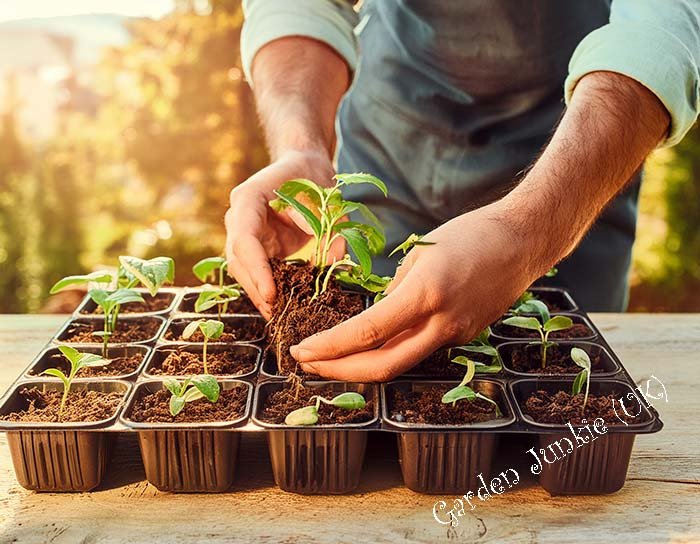
Gardening Month by Month – June: Continue to ‘Prick Out’ Your Seedlings And Transplant Them to Their Final Place.
In June: Fruit & Veg
- Cucumbers, the timing for planting and growing cucumbers varies depending on whether you are cultivating indoor or outdoor varieties. For ‘indoor’ cucumber varieties like ‘Carmen‘ and ‘Emilie‘ they can be sown in heated greenhouses, from late winter to early spring. To begin ‘outdoor’ cucumbers, varieties like Marketmore and Burpless Tasty Green, you can sow them now in June in pots indoors.
- Plant/Sow outside in June, now the soil has warmed up, French Beans, Radishes, Peas, Turnips, Endive, Lettuce, Carrots, Runner Beans, Beetroot, Swedes, Kohlrabi, and Courgettes in successive batches to avoid waste.
- June is an ideal time to start ‘trimming’ (pruning) plum and cherry trees.
- To maintain the health of any fruit grown in containers, like blueberries or certain types of fruit trees, provide them with a high-potash liquid feed.
- It is better to water container-grown blueberries, cranberries, and lingonberries (Vaccinium vitis-idaea) with rainwater instead of tap water. The lime present in tap water can decrease the soil’s acidity over time.
- Certain apple trees may experience a “June drop,” shedding excess fruit. Following this ‘drop’, it is advisable to thin out the tree if the branches remain overcrowded.
- If your ‘soft fruit’ attracts a lot of attention from birds and other wildlife, consider using ‘netting’ to shield your plants.
- Now in June, you should finish earthing up ‘main crop’ potatoes.
- June is a great time to plant quick-growing vegetables, such as lettuce, radishes, spinach, and Swiss chard, every 10-14 days to guarantee a nice steady harvest.
- If you are planting out Autumn or Winter cabbages, now in June, don’t forget to utilise brassica collars to deter cabbage root fly.
- Propagate herbs like ‘marjoram’ and ‘sage’ by taking softwood cuttings this month, planting them in a ‘gritty compost‘, and positioning them on a sunny windowsill.
- Pumpkin, June is a great time to plant/sow them indoors (windowsill, greenhouse, or conservatory) are all suitable locations to place them.
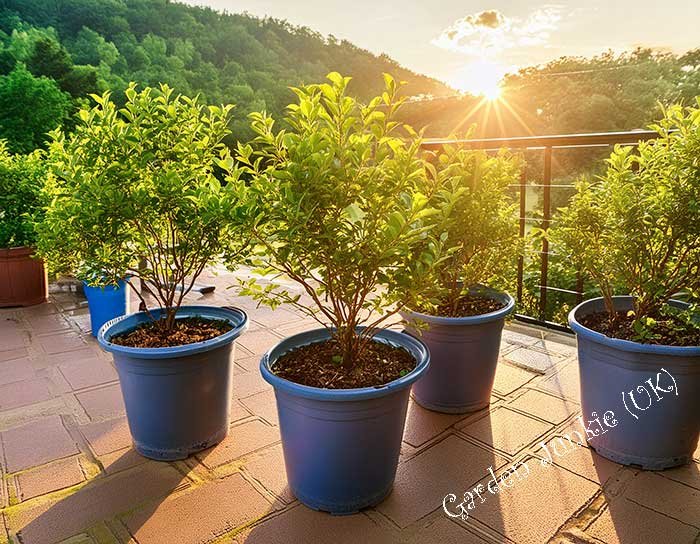
Gardening Month by Month – June: To Ensure Your Fruit Bushes Remain Healthy Provide Them With a High Potash Feed.
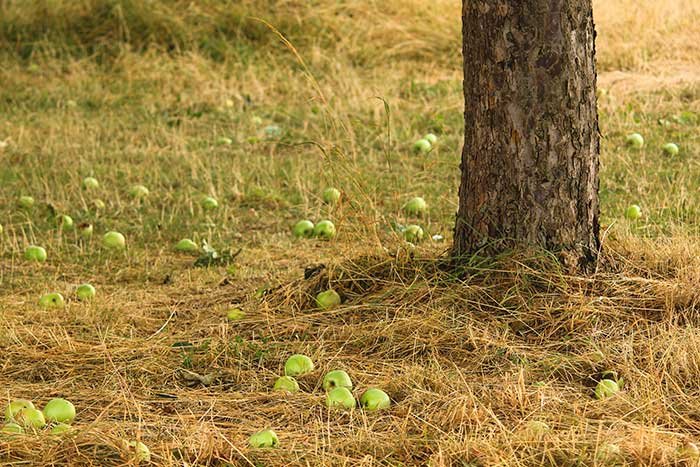
Gardening Month by Month – June: Certain Apple Trees May Experience ‘June Drop Off’ By Shedding Excess Fruit
In June: Pond Care
June in the UK brings warm weather and generally, plenty of sunshine, making it a crucial time for pond care. Here are three key tasks to ensure your pond thrives:
Manage Plant Growth: June is the peak growing season for aquatic plants. Aim to keep about half the water surface clear to allow sunlight penetration and gas exchange. Trim overgrown plants, removing dead or decaying leaves to prevent them from decomposing in the water.
Maintain Water Quality: Warmer temperatures can lead to oxygen depletion and algae growth. Regularly top up pond levels with rainwater if necessary, avoiding tap water due to its chlorine content. Keep an eye out for excessive weed, and consider using ‘barley straw‘ or ‘barley straw extract‘ for natural algae control.
Fish Care: If you have fish, June is a good time to introduce new ones, as long as the water temperature is warm enough. Acclimatise them properly by ‘floating’ the bag in the pond for temperature adjustment before releasing them. Allow the bags containing the fish to float in the pond for about ten minutes. This will help to equalise the water temperatures inside the bags with those in the pond. Place the fish into the pond to ensure they have an ample oxygen supply. Monitor their feeding habits and adjust portions to avoid overfeeding, which can pollute the water.
- To encourage a stronger association between you and your fish, consider feeding them smaller portions of food more frequently. This will help your fish associate you with feeding time, ultimately making them more comfortable and carefree around you. Additionally, feeding in smaller amounts can prevent overfeeding, which can lead to food decay in the pond and disrupt its natural balance.
- Suppose you notice any indication of illness in your fish or other abnormalities. In that case, we recommend referring to this blog post from ‘Pondkeeper’ ‘titled “Diagnosing Your Fish” to identify any issues and find a solution.
- Plants that thrive in deep water, such as water lilies, will experience vigorous growth through late spring and summer. Enhancing their planting baskets with fertiliser sticks will promote more abundant flowering.
- It is best to refrain from adding ‘goldfish’ to any natural wildlife pond as they can disrupt the ecosystem’s natural equilibrium.
- In June, tadpoles transform and develop into young frogs and toads, which will begin to leave the pond. It’s important to support their transition by maintaining the water level, preferably using rainwater, and creating a ‘protective cover’ at the pond’s edge. To achieve this, you can allow a section of the lawn to grow longer or add perennial plants.
- To ensure the well-being of your pond, it is advisable to consider investing in a mechanical air pump. This is because, as the temperature rises and the amount of sunlight increases, the oxygen levels in your pond may decrease. By incorporating a mechanical air pump, you can effectively maintain the cleanliness, clarity, and balance of your pond, as it promotes the growth of beneficial bacteria.
- It’s important to monitor ponds that have abundant plant life for indications of low oxygen levels in the morning (fish gasping at the surface of the pond or at any entry points for water (waterfalls, fountains).
When a pond is ‘densely’ populated with plants, it can result in ‘decreased oxygen’ levels, as plants consume oxygen during the night.
In such cases, it may be necessary to ‘lightly spray’ water from a hose onto the pond’s surface or consider reducing the number of plants. It is generally advised to aim for around 50% coverage of the pond with plants, as excessive coverage can potentially harm the pond during the night.
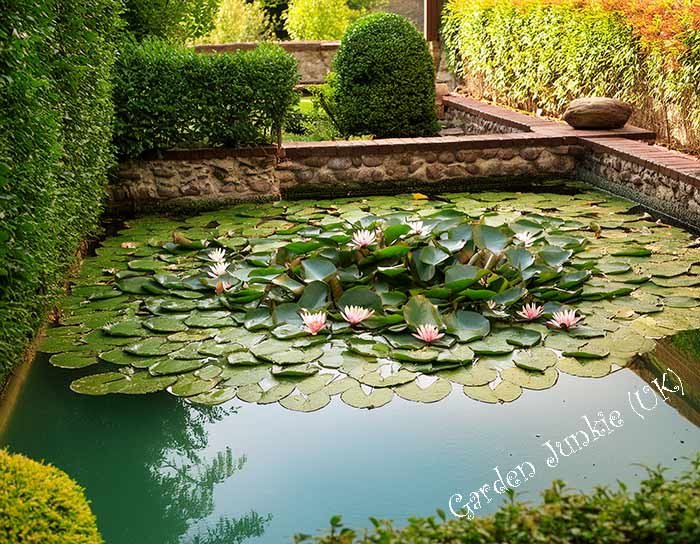
Gardening Month by Month – June: No More Than 50% Of Your Pond Should Be Covered With Plants. Excessive Coverage Can Potentially Cause Harm.
In June: General Garden Maintenance
June is a critical time for general garden maintenance as the weather warms up and plants begin to flourish. This is the perfect opportunity to tackle tasks such as weeding, mulching, and pruning to ensure a healthy and vibrant garden throughout the summer months. By staying on top of maintenance in June, gardeners can set the stage for a successful growing season.
Weeding is important in June. Warmer temperatures make ideal conditions for weeds to grow. Regularly removing weeds helps prevent them from competing with your plants for water and nutrients.
Mulching is also important during this time to help retain moisture in the soil and suppress weed growth. Additionally, pruning any overgrown or dead branches can help promote healthy growth and improve the overall appearance of your garden. By taking these maintenance steps in June, gardeners can set the stage for a beautiful and productive garden in the months to come.
In addition:
- Be sure to regularly feed your container plants and hanging baskets with a liquid fertiliser every couple of weeks to promote blooming.
- Remember to regularly refill bird baths with fresh water since birds require a daily source of clean water.
- Spray roses that are displaying symptoms of disease, such as black spot, powdery mildew, or rust, with an appropriate fungicide.
- Remove perennial weeds, such as couch grass and bindweed, from the garden as soon as you notice them.
- Before you begin trimming or pruning hedges and shrubs, it’s important to carefully inspect them for any signs of nesting birds. This is to ensure that you do not accidentally disturb or disrupt any ‘nesting’ birds during their breeding season. It’s crucial to be mindful of the wildlife in your garden and take the necessary precautions to avoid any harm to nesting birds.
- Continue to feed lawns with a liquid or granular lawn fertiliser. Moss will then be easier to remove.
- Pinch out and tie in tomatoes
- To get rid of algae on pathways, you can use a stiff-bristled brush or a pressure washer to scrub it away. If the algae is particularly stubborn, you may also consider using a commercial algae-killer product to effectively eliminate it.
- Inspect and fix pergolas, arbours, and arches as necessary.
- Review the contents of your garden shed and discard any outdated garden chemicals. If you are uncertain about how to properly dispose of these chemicals, you should seek assistance from your local waste disposal facility.
- During periods of dry weather, it is advisable to apply wood preservatives and ‘stain’ to timber structures like fencing and decking. It is important to carry out these tasks in a well-ventilated area to minimise potential risks to your respiratory system and eyes. Additionally, it is crucial to use suitable and legal products for this purpose, as certain substances such as creosote are no longer permitted for use.
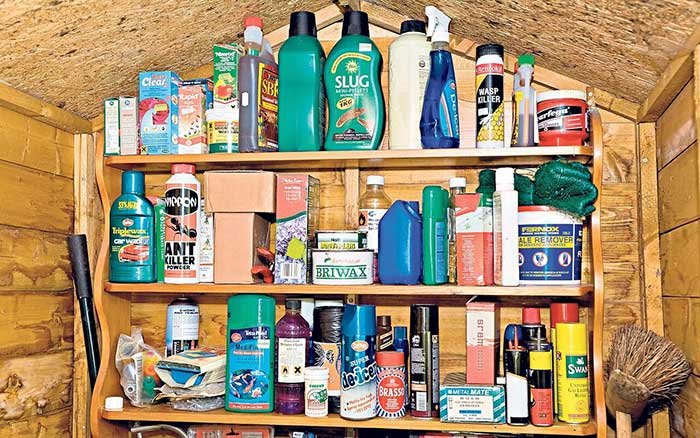
Gardening Month by Month – June: Remove Any Old ‘Out Of Date’ Garden Chemical From Your Shelves. Dispose of Them Responsibly
FAQ’s
What Are Some Lesser-Known Flowering Plants That Thrive in The UK During June?
In addition to well-known flowers like roses and peonies, there are several lesser-known flowering plants that thrive in the UK during June.
Some examples include Aquilegia (Aquilegia vulgaris) or Granny’s Bonnet, Astrantia (Astrantia major), or Masterwort and Campanula (Campanula latifolia) or Giant Bell Flower, and Eryngium (Eryngium bourgatii) or Sea Holly.
These unique and beautiful flowers can add diversity and visual interest to your garden.
What Are Some of The Best Eco-Friendly Pest Control Methods For Dealing With Garden Pests During June?
In the UK, eco-friendly pest control methods for dealing with garden pests in June include: Encouraging birds and beneficial insects ( ladybirds) into the garden, ‘handpicking’ larger pests like caterpillars, and using organic sprays or soaps to deter common pests like aphids and slugs.
Additionally, companion planting and maintaining healthy soil can help prevent pest infestations.
How Can I Make The Most of The Longer Daylight Hours For Gardening in The UK During June?
With longer daylight hours in June, you can maximise your gardening time by scheduling tasks such as watering, weeding, and harvesting in the early morning or late evening when temperatures are cooler.
Additionally, consider utilising the extra daylight for extended planting sessions or for tending to more time-consuming garden projects.
